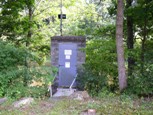West Virginia Water Science Center

DATA CENTER
INFORMATION CENTER
ABOUT THE WV WSCUSGS IN YOUR STATEUSGS Water Science Centers are located in each state. 
|
Featured Project: Emerging contaminants in the Upper Potomac River Basin
Background In 2002, West Virginia Division of Natural Resources (WVDNR) began receiving reports of fish kills in the South Branch Potomac River. The dead fish, primarily smallmouth bass, were found throughout lower reaches of the South Branch. Additionally, anglers perceived a decline in what was considered a premier smallmouth bass recreational fishery. WVDNR initiated a study of smallmouth bass health with assistance from the USGS Leetown Science Centers National Fish Health Research Laboratory. Abnormal gonads were observed in a high percentage of the fish examined. The high rate of “intersex” warranted concern for the potential presence of chemicals that can interfere with the natural system of communication within an organism that controls development and reproduction. Many of these compounds have only recently been detected in the environment and are referred to as “emerging contaminants”.
This Study A cooperative study by the USGS West Virginia Water Science and Leetown Science Centers, West Virginia Department of Environmental Protection, and WVDNR was initiated in 2004. It included: • Water sampling, including: – Passive samplers that accumulate chemicals from the water over a period of time, – Sampling for indicators of agricultural runoff, and – Selected wastewater effluent sampling. • Smallmouth bass plasma analysis for: – Contaminants, and – Reproductive markers (such as vitellogenin, an egg yolk precursor protein expressed in female fish). • Laboratory analysis using several bioassays and chemical concentrations observed in the environment to demonstrate potential linkages between contaminants and biological effect.
Interim Findings (USGS OFR 2006-1393) • Pesticides, industrial chemicals, and flame retardants have been found in passive samplers and in smallmouth bass plasma. • Many of these chemicals have been found in samples from the South Branch Potomac River, the adjacent Cacapon River, and a stream site outside of the Potomac drainage with low population density and no significant industrial or municipal wastewater discharge. • Some of the compounds detected have been identified in the scientific literature as suspected or potential endocrine disrupting chemicals.
Ongoing Study Activities • Water, sediment, and fish tissue samples continue to be analyzed. • Laboratory studies to demonstrate the linkages between the occurrence of intersex and specific chemicals or combinations of chemicals detected in the environmental samples are continuing.
|